Table of Contents
Methodology
When attempting to garner understanding of how the student body at Rutgers implements technology in their everyday routines, effective techniques of surveying students required the usage of technology itself. 63 students and one alumni anonymously completed an electronic survey that was created with Google Forms. The main form of interviews were conducted over text messages. Because students are immersed in technology, the most effective way of reaching them to willingly comply in providing information required using platforms they were familiar with.
The ease of communication through technological platforms like social media and texting is not only present in the interviewees’ answers, but also in how the interviews themselves were conducted. A survey on the platform Google Forms was shared on all social media platforms, group chats, and text messages as a hyperlink to reach as many people as possible. Text messages can easily be answered by interviewees wherever they choose so long as they have their cell phone. The formalities of a recorded physical interview can exude professionalism and reveal the organization of thoughts that text messages do not display. The difficulties of conducting a formal interview, however, require coordination that is not required of our methods, like reaching out to interviewees beforehand, designating time set to conduct the interview, as well as finding a physical space that will allow for effective, clear responses. With a quick survey, students do not feel obligated in committing too much time that a formal interview would require. With text messages, interviewees can provide answers whenever they choose is most appropriate in their schedule. Additionally, the elements of setting a mutual time and place to conduct the interview are not needed.

The use of text messages as interviews also reveal how students convey information to one another everyday. Not only do iPhone screenshots represent what most students see when interacting with others, the use of grammatical errors, incorrect spelling, and internet slang display the informality and overall ease of the platform. The lack of a period is not problematic when the text-er can convey what they want to say effectively.
Students that were questioned discussed the role of technology in major facets of their everyday routine at Rutgers. Social media is described to be the main form of communication between peers. Through professors’ obligation to utilize online classroom platforms like Sakai, students also find themselves employing technology in order to properly complete coursework. The internet is so widely used that it allows for students to gain an income and increase their campus organization attendance by directly reaching their audience through social media platforms. The ease of technology that students use has increased its prevalence to necessity. Students, however, also describe the large social consequences that the constant presence of technology was responsible for, like social media’s superficiality, constantly being distracted from human interactions, and hostility women face on the internet.
Social Media
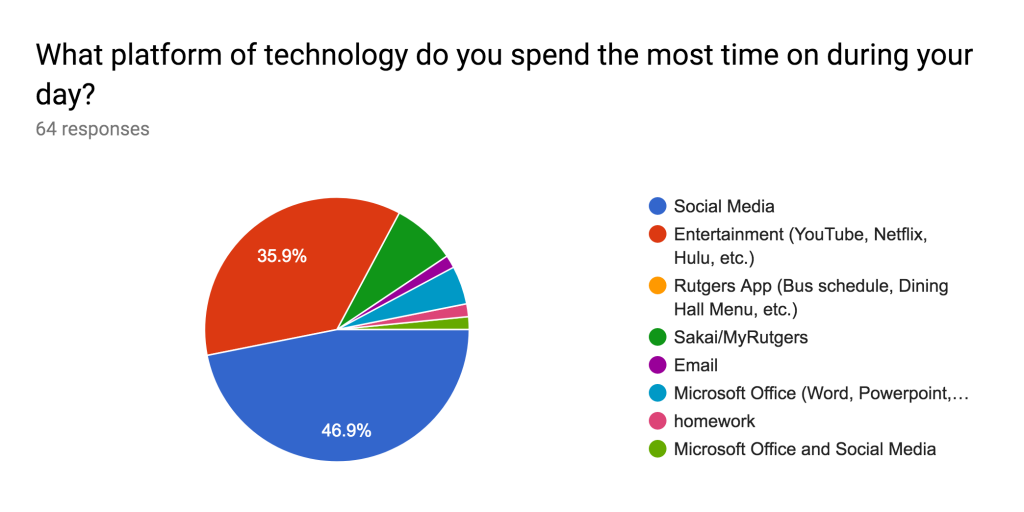

Despite using social media like Instagram to bond and connect with her friends, Coughlin admits to its distraction. However, social media and technology are essential for college social life. Expectations of how one interacts with her friends go beyond hanging out in a student lounge for a specific amount of time. The interaction between friends continue over technology and social media.
Brigie Coughlin is a students of Rutgers University and speaks of her experience communicating primarily through technology. She also mentions the female experience on the internet and its resulting hostility as a result of the ease of what is socially allowed online.
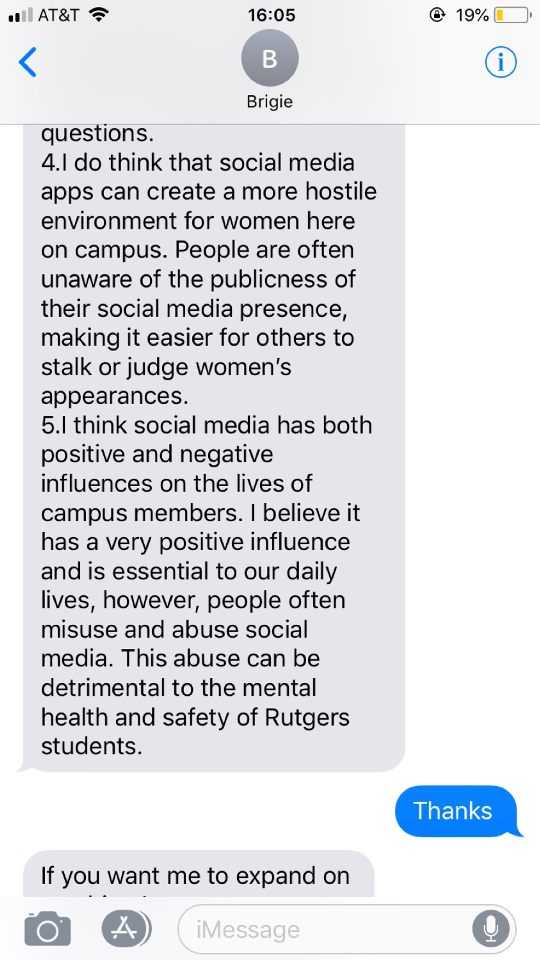
The female experience on the internet according to Coughlin is one of hostility. Women find themselves vulnerable to not only negative feedback to their visible online lives, but also to personal judgement through expectations set for women displayed through social media. Platforms like Instagram rely on photos. Physicality’s of a woman are targeted through such visually-obligated mediums like pictures.
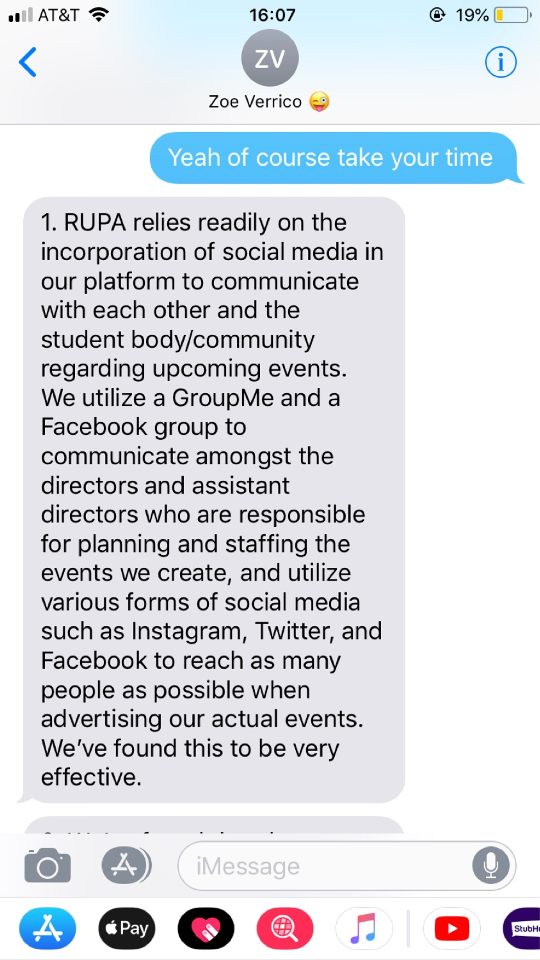
Because RUPA’s rating of a successful program involves student participation, information about their programs need to be spread amongst many people at once. With so many different forms of social media, RUPA has found it effective to utilize the most popular forms like Facebook, Twitter, GroupMe. and Instagram. Each platform requires different forms of media (i.e. Instagram is primarily photo-based while Twitter is primarily text-based), Verrico believes that the versatility of Facebook is most effective when advertising for programs. They are able to reach their many followers without physically interacting with each student they potentially reach on Facebook. Without social media, RUPA would perhaps print out physical flyers of programs and place them around campus or physically take time to hand them out.
Zoe Verrico is Rutgers student that is a part of RUPA (Rutgers University Programming Association) and represents how student organizations on campus heavily rely on social media’s ease of reaching many people at once. She also argues against the constant use of social media and its downfalls that are incomparable to human interaction. This give and take relationship described in the interviews above demonstrates a paradox of sorts among Rutgers students. They describe technology and more specifically social media as a necessary tool for conducting their social lives here on campus, yet they highlight many downfalls of this trend that have potential to harm students on campus. Furthermore they as we will see many students resent the necessity of social media in their daily lives whether it be academically or socially and yet they are forced by the current social setting to engage in these practices.

Though social media has become essential for RUPA to advertise their programs, what remains more effective, according to Verrico is physical interactions with students through “word of mouth”. The intimacy of one student talking about a RUPA program to another student proves to be more genuine and convincing than a sterile Facebook event post. As RUPA continues to increase it’s technological use of advertisement, human interactions remain.



Verrico argues the usefulness of social media through RUPA, but also argues for less usage of it. According to Verrico, the intimacy between human interactions are lost through social media. As technology appears to be more useful, its heavy presence makes Verrico weary of its social implications as well as over-consumption of such technologies. Social media and technology itself cannot replace aspects of in-person communication, like hearing one’s vocal inflections or being in deep conversation that is not shortened by the medium of texting.

Despite speaking about social media as crucial to the success of RUPA, Verrico does not fail to perceive the negative consequences social media has on impressionable students. Increased visibility due to social media ironically sanitizes how one views another person’s lifestyle on display. The pressure for acceptance through likes and views provides falsehoods for the perceptive audience.
Social media represents a double edged sword, it can be used for helping students in their extra curricular activities such as RUPA and serves as a platform of mass communication for many student activist groups and charity organizations here on campus. It also poses a threat to the way students interact with each other, and how students perceive themselves, particularly women on campus. Building off of Amanda Hess’ ideas in Why Women Aren’t Welcome on the Internet most women interviewed specifically noted that constant usage and reliance on social media in a college setting negatively impacts women’s personal safety and mental health. This is a major social issue here on campus that is fueled by social media apps such as Instagram and Snapchat and yet those two apps are the most commonly used among those interviewed. Even with the potentially negative implications of social media on the health and well-being of students here on campus they still actively engage in those potentially dangerous social media platforms because they find it necessary to engage in those platforms in order to participate in campus social life. This begs the question, why is social media a necessary part of campus social life now? Years prior social media did not even exist and now that it does everything that exists in the physical world in making its way into the digital world. Students on campus feel they absolutely need a technology that is a recent trend in order to engage in social practices long since established, is this reliance a certain form of addiction to these social media apps? Or is it part of a broader social change to exist in two worlds at once, the digital and the physical?
Education
The Rutgers student experience through education cannot depart from technology’s presence through the use of classroom platforms like Sakai, Microsoft Office, and Google Drive. Professors are able to reach their students in a timely manner through Sakai announcements and email. Students can retrieve coursework materials at their discretion through Sakai. Beyond the educational uses of technology, students also regularly find themselves intersecting other aspects of technology that do not relate to class, like online shopping and social media. The students that were surveyed appeared to be in consensus of the overwhelming distraction technology serves, obstructing effective learning. It is easy for a student to begin online shopping when taking notes from a professor’s lecture. Technology in the classroom, therefore, cannot be portrayed as either helpful or not helpful. Students were asked in what ways has technology contributed or hindered to the academic environment? The answers provided reveal the nuanced usage of technology through its essentialness but also its negative consequences.

“I can get through an entire semester without ever going to class, seeing my professor, or even knowing who they are. Thank you PowerPoints.”
“I’m currently in class just surfing my social media apps. That’s why I’m able to reply to quick to this survey, sometime social media is just way more intriguing than actually fully paying attention all the time”
“Technology makes it easier to obtain information and get in touch with professors and other students. However, we rely so much on technology that if we didn’t have the bus app, students may be less likely to go to class. Or if we weren’t allowed to use laptops during class grades might improve because this hinders students from going on other sites during class.”
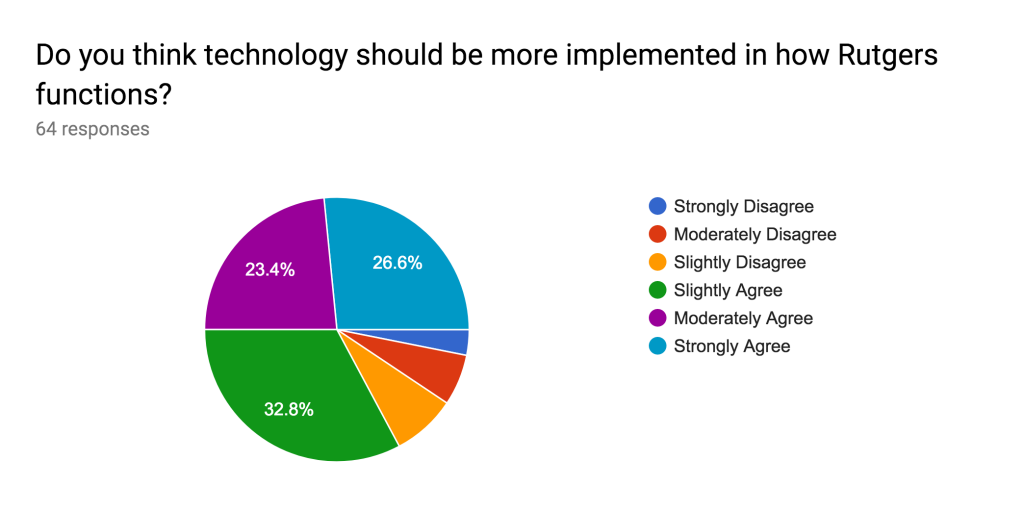
“Its annoying that everything relies upon technology now. Technology doesnt always work right and sometimes the student is blamed for poorly working technology.”
“It has created a very hands-on and engaging learning environment and makes homework more convenient”
“Online study tools, online homework, the ability to use software for assignments such as essays, the ability to do work regardless of location, easier organization of textbooks”
“Technology allows students to have access to vast amounts of information anytime and anywhere”
“Technology has contributed positively, because We are now able to send messages to classmates and ask for help. Professors are constantly sending reminders on when an assignment is due.”
“Contributed: I tend to learn more online than I do from a majority of my professors. The internet is truly the reason for my academic succes. Hindered: Social media is definitely a distraction. Also, social media definitely encourages people to bandwagon on certain opinions when they should be forming their own.”
In what ways has technology contributed or hindered to the academic environment?
“Distraction”
“Distracting”
“Cell phones are the devil. Good for communication but very distracting with so much you are able to do at the palm of your hands, making it easy to not focus on school work. I believe it has also played into students having shorter attention spans than before technology.”
“Huge distraction.”
“distractions from working”
Social media can be really distracting when you’re trying to do work. I find myself actively having to put my phone away from me at times to make sure I don’t get distracted by it.
One of the obvious concerns of technology use in the classroom among students is how aware they are of technology’s ability to be extremely distracting. With technology as the main form for obtaining coursework, taking notes, and interacting with the professor outside of the classroom, its multipurpose element of also containing social lives outside the classroom make it difficult for students to focus. There is, however, ease in interacting with the course material that cannot be done manually. Professors can easily communicate with students last-minute logistics or even an interesting article that can enhance the syllabus. Technology’s increasing presence allows professors and students to interact with course material that cannot be done with simply an oral lecture. But technology also serves to hinder how students learn, complicating whether technology belongs in the classroom or not.
The trend seen with social media and how it affects the lives of students on campus carries over into their academic careers, as seen from the anonymous survey above a vast majority of students feel that digital technology in the classrooms and libraries significantly negatively impacts their academic careers. Yet, these technologies are relied upon and never abandoned by students. Cell phones in particular are highlighted as one of the main distractions and severely impacted the ability of students to focus in class and in their own study time. Fascinatingly even when students realize the negative affect the phone is having on them academically they still bring it with them to class and carry it on them at the library or in their private studies. This more so begs the question of is the phone addictive? Have students on campus become so immersed in living a digital life that they can’t forgo interacting with their digital selves even when doing so would be a benefit to them?
Employment
Dylan Koenig is a Rutgers student responsible for promoting Top Tear that specializes in serving the collegiate demographic through experiential marketing, live events, concert through the use of brand ambassador programs. Intersecting the use of social media for his own employment, Koenig represents students that use technology used not only for connections to other students and organizations, but also as a source of income. Undergraduate students here on campus have grown up surrounded by digital technology. For the students here on campus learning how to use digital technology was as symbolic a right of passage as learning how to ride a bike or drive a car. With digital technology so constantly involved in our day to day lives it has opened up the doorway to new possibilities for students to pursue a career in. Much of the physical world is becoming digitized, and with that certain career paths are also becoming digitized. Advertising, marketing among many other career paths are now performed primarily threw digital means. Students having grown up with the digital technology are some of the most adept in the world at using that technology and understanding the way in which their peers interact with technology, leaving students at an advantage when pursuing career opportunities that exploit their skills with engaging in digital technology.

With an occupation that relies heavily on promoting to the collegiate student bodies like Rutgers, Koenig finds it most effective to reach a large number of people at a time by utilizing a platform students actively find themselves on.
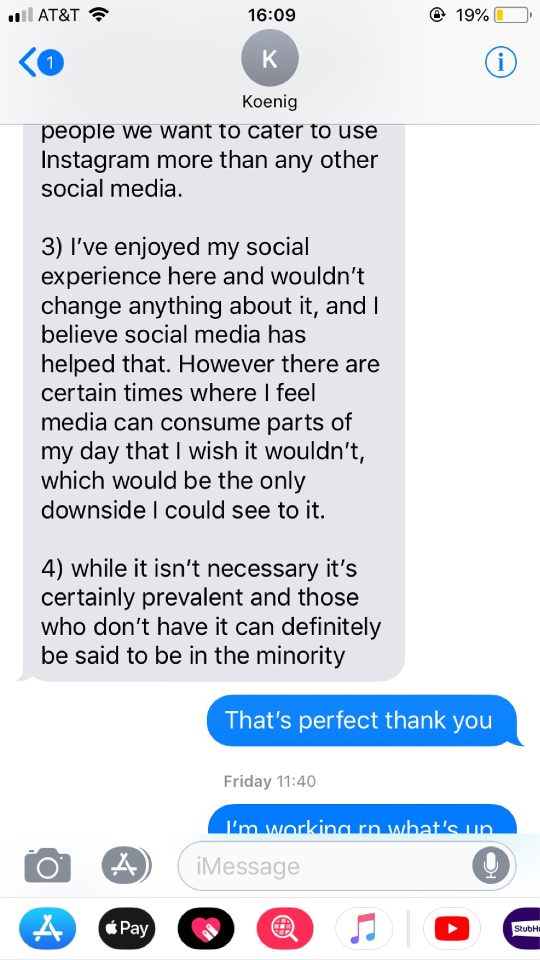
Koenig believes it isn’t necessary to employ social media in everyday social interactions, but social media’s heavy presence in the routines of most students’ reflects the normality of such technological platform. Consequently, without social media, it would be very difficult for his business of entertainment and promotion to be as successful as it is now in producing an income.
